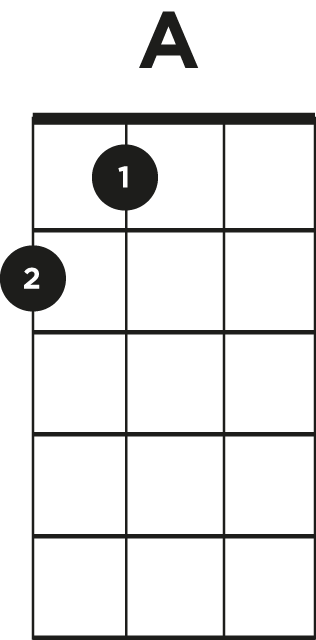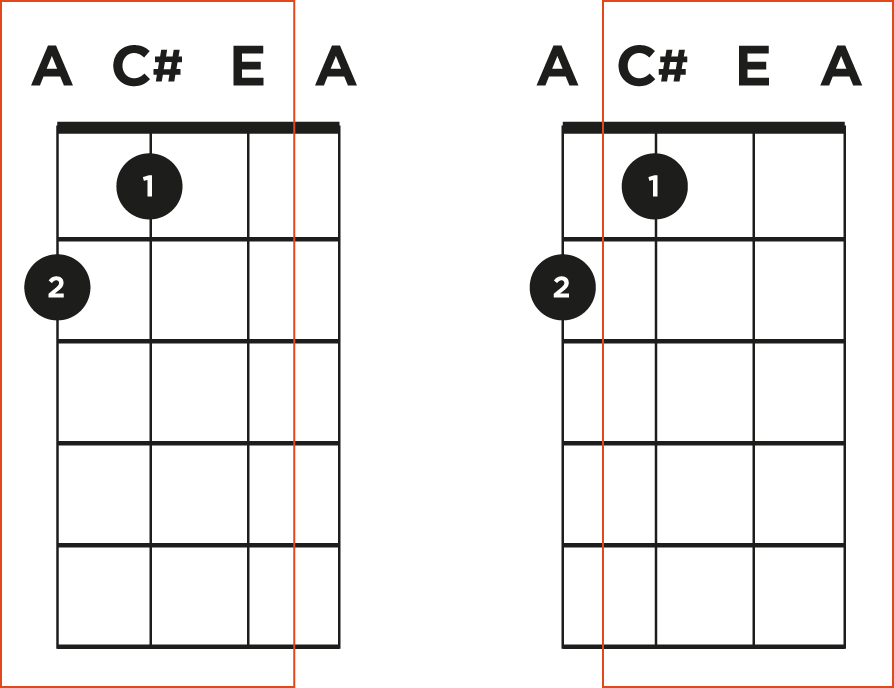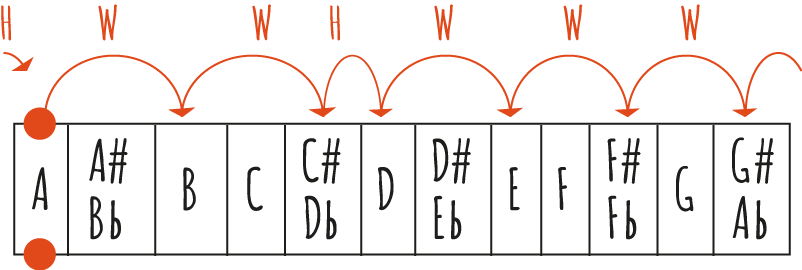It’s time for a little more music theory, don’t worry though, we’ll take it nice and steady. Today we’re looking at major chord construction, which is really useful to understand for a number of reasons.
It just takes 3 notes
All major chords comprise of just 3 notes. This may seem illogical as for the most part you’re used to strumming all 4 strings when playing chords. 4 strings mean 4 notes right? Sort of.
When you’re playing a major chord on ukulele and you’re strumming every string, you’re actually playing just 3 notes, it’s just that two of them are the same note. You’re essentially doubling up one of the notes and playing it twice.
 For those that came to ukulele from another instrument such as guitar, the same principle applies, you just happen to double up more notes on a guitar as it has more strings in the first place.
For those that came to ukulele from another instrument such as guitar, the same principle applies, you just happen to double up more notes on a guitar as it has more strings in the first place.
Let’s take a chord as an example and we’ll use the A major chord. Second finger, second fret of the G string (top) and first finger, first fret of the C string (next string down). Take a look at the chord box to help you out.
Pluck each note once and listen. Did you hear the two notes which are the same? Hopefully you did. The two notes which are the same in this version of an A chord are the notes on the top and bottom string (both of which are the note A).
Technically, as a major chord only comprises 3 notes, you don’t need to play both A notes to play an A major chord. You could just strum the top 3 strings, or equally you could strum just the bottom 3 strings. Whichever you choose, you’ll find all the notes you need for an A chord are contained within. That’s the notes A, C#/Db and E. Have a look at the diagram below which should help illustrate this.

But why is this useful to know?
Firstly, this is really useful to know because it can help you if you find a particular chord difficult to play. Most ukulele players struggle with the E chord, at least to begin with. But you can make it a whole lot easier by not playing and subsequently, not having to fret one of the strings. In fact, I wrote a whole other blog post just for the E chord (and it has a video too) that talks about this very approach.
That’s not the only reason that it’s good to get to know the notes that make up a chord though.
 How about some more examples?
How about some more examples?
This time we’re going to look at the C major chord. Everyone knows the C major chord right? If you don’t yet, have a look at the chord box opposite. The top 3 strings are all open and the bottom string (the A string) is held at fret 3.
In terms of the notes you’re playing here. You have G, C, E and another C on the bottom string. As I mentioned in the example of the A chord, you should be able to hear that 2 notes are the same. In this example, it’s the C on the second string and the C on the bottom string. There is a slight difference when it comes to this version of the C chord though, the 2 C notes you can here are actually an octave apart.
How do I work out the notes in the chord?
So the next thing you need to know is how to work out which notes you need to play. For this, you need to get to grips with the notes in the scale.
Let’s start by laying all of the possible musical notes down. You can see there are 12 available, after which the pitches repeat in a higher octave.

Each note in western music is considered to be a semitone (or a half step), two semitones makes a whole tone. If we translate that onto the ukulele fretboard, each fret is a semitone/half step and 2 frets is the equivalent of a whole tone/step.
To construct a major scale, there is a formula, and that formula is whole, whole, half, whole, whole, whole, half.
So lets build a C major scale. Starting on the notes of the scale we move up a whole step which gives us a D, we then move up again a whole step which gives us an E. We continue this pattern until we have built all of the notes in the scale which will eventually give us: C, D, E, F, G, A, B.

Now we have the C major scale built we’re ready to construct our major chord.
Major chords are built from the root note (the note that is the same as the name of the chord), the major third and the fifth. This would give us C, E and G, exactly the notes we need.
- C – Root
- D
- E – Third
- F
- G – Fifth
- A
- B
Let’s try it again with our A chord.
We start by building the scale. Using A as our root note, we move up using the scale formula from above. This will give us A, B, C#/Db, D, E, F#, G#

Again using the root, third and fifth formula for major chord construction. This gives us…
- A – Root
- B
- C#/Db – Third
- D
- E – Fifth
- F#/Fb
- G#/Gb
It does take a little bit of working out but this all comes in very useful as you become a more accomplished player. You’ll find new possibilities and become a much more competent player.
Let me know in the comments if you’ve found this useful!




THANK YOU X a thousand. I will almost be sleeping with all the great info!
My pleasure
This is very interesting! You made an amazing simple explanation of chords and scales. Thank you!
Yup, very helpful! Thanks for the beautiful explanation!
You’re welcome, I’m glad you found it helpful.
Lower chords are easier to sing / play along with other video etc. The Saprano, Concert, Tenor are too high. The Baritone is lower but you have to use DGBE tuning or, GCEA works but is Too high like the other Ukuleles. In DGBE, the ‘F’ chord is to hard for my fingers with arthritis. So, all I accomplished is a bigger ukulele ?
You can always sing down the octave or change keys to suit your voice. Don’t underestimate your range, though. Many people do this and from a vocal perspective it’s very limiting and unnecessary.
PS
A baritone uke pretends to be a guitar. It has a terrible time, demands different tuning. IMO is a useless excuse for a uke. Now a bass uke! That’s a different matter!
A-C-E. Dave! Very clear and you have succinctly explained The basis of music theory where the school system music teacher a didn’t succeed! Thank you – do you have an Ebook with this info all in one place? It’s something I’d really value in my elibrary and on a shelf/ music practice file!
A-C-E. Dave! Very clear and you have succinctly explained The basis of music theory where the school system music teacher a didn’t succeed! Thank you – do you have an Ebook with this info all in one place? It’s something I’d really value in my elibrary and on a shelf/ music practice file!
Excellent explanation. At last the penny has dropped!! Many thanks
I’m glad it helped Dave